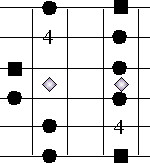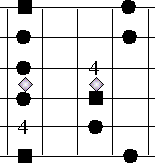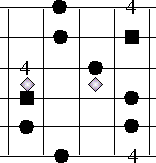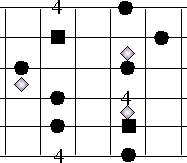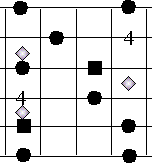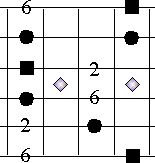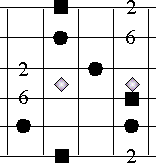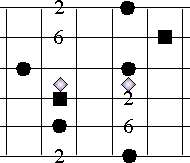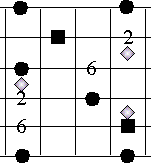Pentatonic Scales
Pentatonic scales are generally the easiest scales for people to begin improvising with. There may be some connection between this fact and the fact that pentatonic scales are the oldest known form of tonal organization.
Outside of triad and 7th chord arpeggios, the major and minor pentatonic scales are the most basic melodic tool available.
Major:
The major pentatonic scale consists of the intervals 1 2 3 5 6. The absence of the 7th interval allows this scale to blend nicely with practically any type of major chord or unaltered dominant chord.
Now, since you already have the R 3 5 mapped out over the entire fingerboard, all you have to do is add the 2 and 6 to get the major pentatonic scale:
Minor:
The minor pentatonic scale has the intervals 1 b3 4 5 b7. This scale blends well with minor triads and minor7 chords. This is due to the fact that the minor pentatonic is simply the minor7 arpeggio with the 4th interval added. Since you already have the minor7 arpeggio worked out, all you have to do is add the 4th:
Now, if you compare the way that the major and minor pentatonic scales lay out across the fingerboard, you will notice that both scales form identical shapes.
First, lets break the minor pentatonic up into five fingerboard positions:
Compare this to the major pentatonic:
We get the same shapes.
The fact that both scales are identical in shape makes learning these scales very easy.
Other Pentatonic Scales:
I have found two variations of the minor pentatonic scale to be very useful.
The first is what I call the dominant pentatonic scale. The dominant pentatonic scale has the intervals 1 3 4 5 b7. As the name implies, this scale works great over dominant chords.
The second variation is useful for playing over the min7b5 chord. All you have to do is flat the 5th of the minor pentatonic. This gives us 1 b3 4 b5 b7.
Here are a couple more pentatonic variations:
Japanese minor: 1 b3 4 5 6
Exotic minor: 1 2 b3 5 b6
It's also worth mentioning that by adding the b5 to the minor pentatonic, we get what is called the "blues" scale: 1 b3 4 b5 5 b7.
Remember that you need to work this stuff out in every key.


